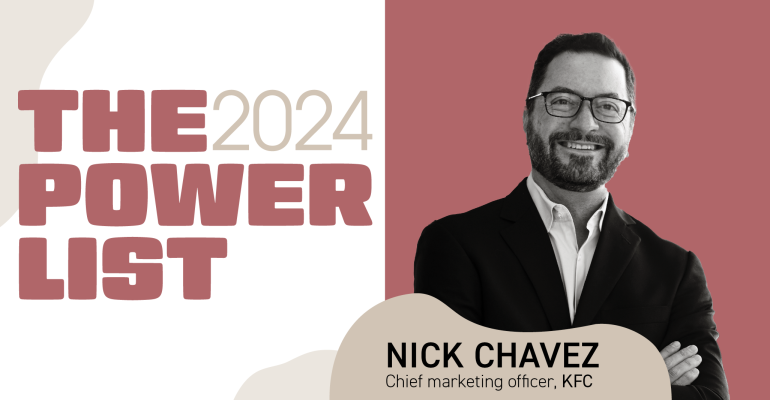Throughout the past couple of years, KFC has made progress toward its objective of attracting younger and more diverse customers by launching boneless, portable offerings like the chicken sandwich, wraps, and bowls.
Its influencer strategy has also helped. KFC has adjusted its marketing strategy more toward social media and streaming services and has recruited collaborators like Deion Sanders, Jack Harlow, and Bad Granny to help showcase those new items.
“We’ve had a steady beat of key celebrity and influencer relationships really designed to engage younger audiences and they have recruited and attracted new interest and trial of our products,” CMO Nick Chavez said during a recent interview.
This co-creator or influencer landscape isn’t new for Chavez, who cut his teeth at Yahoo and Nintendo before coming on board at KFC in late 2021.
“I remember creating an influencer marketing function at Yahoo in 2001,” he said.
Sure, things are remarkably different now, but the objective has remained consistent.
“Some of these things we think are new have been around a long time, it’s just the tools to access influencers and the way they engage their communities are new and it’s constantly evolving. The one thing that’s remained the same is that authenticity is absolutely a priority,” Chavez said.
How KFC strives to achieve such authenticity is by tapping co-creators who are genuine fans of the brand, like fellow Louisville native Harlow and Coach Prime (Sanders). Chavez said the Sanders campaign is the perfect example of a successfully executed authentic campaign.
“Coach Prime’s strongest value is his family. He loves his children. He loves his mama. It was important to him, and important to us that we included his whole family in that content. We could have easily said, ‘No, Coach, we just want you,’ but his values were aligned with ours,” he said.
The company vets all of its influencers, whether earned or paid, to understand their relationship with the brand and to ensure their “values are aligned.” Chavez said this is a key part of the process. From there, it becomes a matter of listening to its community and making sure fans are getting the content they want and where they want it. Chavez also said joint promotion is a priority, so it becomes a win/win relationship.
“It’s important to me that as we build these programs, we listen to (influencers’) communities and jointly promote that content we create in such a way that they can genuinely endorse it,” Chavez said. “Bad Granny just posted some content saying how her partnership with KFC changed her life. That’s what we want.”
Such joint promotion is just one measure of success. The brand also looks at how much buzz a partnership generates and, of course, sales velocity.
“We see direct impacts from influencers, celebrities and other types of partnerships to our brand buzz metrics,” Chavez said. “And we certainly don’t want to alienate or offend existing guests with any type of partnership. We’re always paying attention to what our guests are saying both in restaurants and online.”
That risk of alienation perhaps illustrates the biggest challenge for KFC in facilitating influencer campaigns. KFC audiences are unique, Chavez says; on one hand, there is a growing cohort of younger and more diverse guests, while on the other, the 71-year-old brand has held on strong to its traditional guests, who prefer bone-in chicken and who skew a little older than the quick-service category average. The brand has to strike the right balance between both.
“How we do that is by identifying and understanding those audiences and what products, promotions and offers we have that are relevant to them,” he said. “And we engage them where they are spending their time. What content are they engaging with? What creators? Are they corporate creators, like Netflix or Hulu? Or are they social creators and creators of the new economy creating everyday interactions? We try to map our engagement strategy against those audiences within the channels that are most native and relative to each of them.”
As the creator economy continues to grow, Chavez predicts the next iteration to be the merging of physical and digital experiences, facilitated by co-creation. KFC recently opened a popup “Chizzeria” in New York City to celebrate its new Chizza offering, for instance. That activation was pulled off in partnership with co-creators, including model Haley Kalil (@haleyybaylee).
“A lot of these types of content partnerships are currently primarily designed for social media,” Chavez said. “But we were really excited about our Chizzeria event that was this sort of physical and digital takeover. It took over all of our social channels, our e-commerce channel and influencer and partner channels, but it was also this living, breathing physical event with people lined up 2½ city blocks. This triangulation of the physical world, the digital world and the world of creators comes together for these remarkable experiences that I think are going to continue to scale.”
Contact Alicia Kelso at [email protected]

